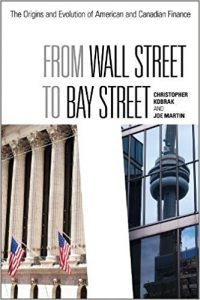If you accept money is the great divider in life – not race, gender or religion – any history of money should expose the core of the Canadian story. It is, and this does. Financial historians Christopher Kobrak and Joe Martin of the Rotman School of Management chronicle 300 years of money in Canada with an account rich in anecdotes and telling in its findings.
Canada today is one of the few English-speaking countries with a central bank that is taxpayer-owned. It was money that smashed the two-party system in Parliament a century ago, and regulation that saved Canadians from a sub-Arctic version of the 2008 panic.
“Canadians have more faith in their political and financial elites’ ability to find socially useful compromises between the rights of creditors and debtors,” authors note in From Wall Street To Bay Street. “Perhaps most importantly, Canadians from their earliest history seemed quite willing to learn from the vigour and foibles of their southern neighbour.” When Canada federalized banking in the Confederation era, legislators were “well aware of the strife and troubles south of the border.” In 1860 the United States had 1,562 banks. Canada had sixteen.
From Wall Street To Bay Street moves at a smart clip with quirky research. Who knew colonial Québec used playing cards as currency, or that the Spanish silver dollar was the most commonly circulated coin in Nova Scotia in 1790?
From 1869 the first Bank Act was introduced, ghostwritten by the general manager of the Bank of Montreal. Banks then and now were powerful in Canada, but not all-powerful. Canada in its first 50 years saw numerous bank failures – seven alone in 1907 – and a rise of political parties devoted to controlling banks including Progressives, Social Creditors and CCFers.
Illustrative of the Canadian story is one of the great High Noon moments in banking on December 14, 1998, when then-Finance Minister Paul Martin vetoed proposed mergers of four big banks – the Royal and Montreal, and CIBC and Scotiabank – into two super-banks with billions in assets. It was “because of a concern about creating banks ‘too big to fail’,” authors note. The decision proved prescient when U.S. bank bailouts occurred a decade later.
The history of money is a history of people. The 1920s did not roar in Canada, authors explain. The collapse of the wheat boom saw the economy shrink by 13 percent in a single year, 1921. And the savagery of the Depression produced statistics that still horrify.
In Saskatchewan in the 1930s, average incomes fell 72 percent. Unemployment in Windsor, Ont. peaked at 50 percent. In Manitoba, then one of the world’s largest wheat exporters to Europe, prices fell to 33 cents a bushel, a valuation not seen since the Middle Ages.
Through the sweat and tears, authors document a uniquely Canadian story footnoted by a singular fact: Canada remains a nation where bankers do not enjoy celebrity status. Very few could name the governor of the Bank of Canada. Many more could name the minister of finance.
By Holly Doan
From Wall Street to Bay Street, by Christopher Kobrak and Joe Martin; University of Toronto Press; 370 pages; ISBN 9781-4426-16257; $34.95









